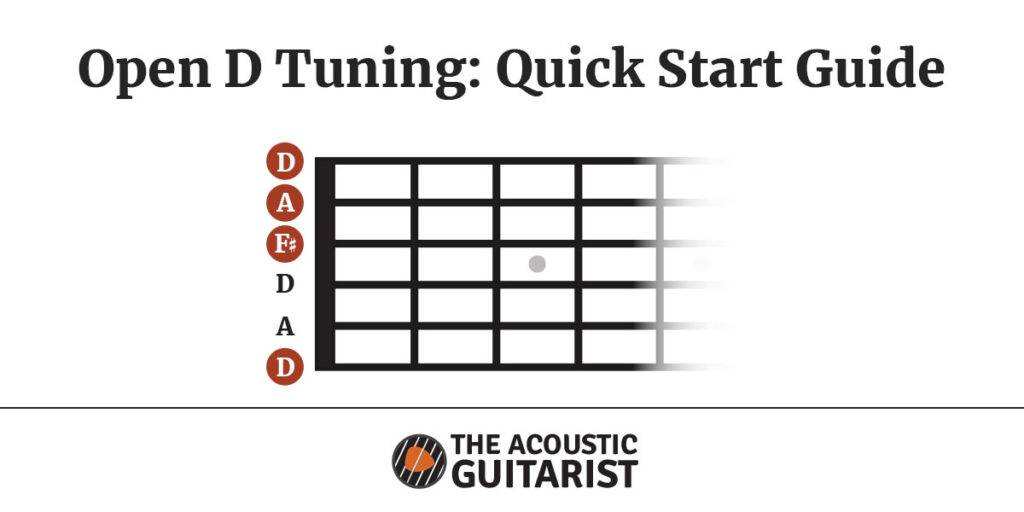Open D tuning offers an accessible gateway into the world of alternate tunings. This tuning, which sets the strings to D-A-D-F♯-A-D, offers a warm, almost ethereal quality, especially suitable for fingerstyle and slide guitar.
In the following guide, you will learn:
- How to tune your guitar to Open D.
- The benefits of open tunings
- Essential (and simple) chord shapes.
- The major and minor pentatonic scale in Open D.
- Some great Open D songs.
- How to approach songwriting in Open D.
The good news is, once you’ve read through the information below you’ll be able to play in this beautiful tuning and have a great foundation to build upon to further your understanding and skills.
Tuning Your Guitar to Open D
Open D is a low-tension tuning, meaning the altered strings are tuned down, reducing the tension of the strings. Unlike Open E for example, which requires three of the strings to be tuned up a half step, increasing tension on the neck of the guitar.
Follow the steps below to tune your guitar to open D.

- Start with the sixth string (low E) and tune it down a whole step to D.
- Keep the fifth string (A) as it is.
- The fourth string (D) also remains unchanged.
- Tune the third string (G) down a half step to F#.
- Adjust the second string (B) down a whole step to A.
- Finally, tune the first string (high E) down a whole step to D.
| String | Standard Tuning | Open D Tuning |
|---|---|---|
| 6 | E | D |
| 5 | A | A |
| 4 | D | D |
| 3 | G | F♯ |
| 2 | B | A |
| 1 | E | D |
* Remember. When tuning to open D always tune the 6th, 3rd, 2nd, and 1st strings down, not up.
Once in tune strum all 6 strings to play a D major chord. Notice how full and rich this sounds compared to the standard open D chord voicing most of us play in standard tuning?
This is one of the benefits of Open D. We can include all 6 strings giving the guitar a rich and full sound.
Open D tuning Fretboard
Once your guitar is tuned to open D the notes on your guitar’s fretboard will be arranged as per the fretboard diagram below.

What is Open D Tuning?
If you are new to the concept, open tunings essentially mean you are tuning the strings of your guitar to a chord, in this case, D Major. This means we take the notes that form a D major chord D(1), F#(3), and A(5), and tune the strings of the guitar to these notes.
Key of D Major
| Scale Degree | 1 | 2 | 3 | 4 | 5 | 6 | 7 |
| Note | D | E | F# | G | A | B | C# |
| Interval | Tonic | M2 | M3 | P4 | P5 | M6 | M7 |
The numbers in the table above represent the scale degrees taken from the accompanying D Major scale used to construct the D major chord.
All chords can be constructed using a formula. For example, major chords are constructed from the 1st, 3rd, and 5th scale degrees of the major scale or the tonic, major third (M3), and perfect fifth (P5).
If we were tuning to DADGAD, which is essentially tuning your guitar to a Dsus4 chord, we would simply replace the 3rd with the 4th (tuning our F# on the 3rd string to G) as sus4 chords are constructed from the 1st, 4th, and 5th scale degrees of the major scale.
The Benefits of Playing in Open D
The major benefit of playing in alternate tunings is that they inspire new creative ideas. They are a great way to break out of a rut if you’re a songwriter as the altered relationships between strings can lead to unique and unconventional melodies and harmonies.
Open tunings especially allow you to either play things you can’t necessarily play in standard tuning or by virtue of the different chord voicings used, can alter the tonality of the guitar and in many cases provide simpler ways to voice chords (more on this shortly).
Playing in Key
It’s common for guitarists to play in the same key as the tuning they are playing in. This simplifies chord shapes and allows more use of open strings to enhance the sound of the guitar. Hence, much of the teaching material you will find related to Open D will provide examples in the key of D.
However, using a capo in an open tuning allows you to easily shift the key of the guitar while maintaining the same open chord shapes and fingerings. To play in different keys, place the capo on the desired fret: each fret higher transposes the guitar up by a half step.
The table below shows all capo positions up to the 12th fret in open D tuning and the respective key:
| Fret Number | Key | New Tuning Notes |
|---|---|---|
| 0 (No Capo) | D | D-A-D-F♯-A-D |
| 1 | D♯ | D♯-A♯-D♯-G-A♯-D♯ |
| 2 | E | E-B-E-G♯-B-E |
| 3 | F | F-C-F-A-C-F |
| 4 | F♯ | F♯-C♯-F♯-A♯-C♯-F♯ |
| 5 | G | G-D-G-B-D-G |
| 6 | G♯ | G♯-D♯-G♯-C-D♯-G♯ |
| 7 | A | A-E-A-C♯-E-A |
| 8 | A♯ | A♯-F-A♯-D-F-A♯ |
| 9 | B | B-F♯-B-D♯-F♯-B |
| 10 | C | C-G-C-E-G-C |
| 11 | C♯ | C♯-G♯-C♯-F-G♯-C♯ |
| 12 | D | D-A-D-F♯-A-D (1 octave higher) |
For example, placing the capo on the 2nd fret transposes the guitar to Open E (E-B-E-G♯-B-E), and on the 5th fret to Open G tuning (G-D-G-B-D-G).
Using a capo in this way maintains the chord structure and fingerings characteristic of Open D, but raises the pitch allowing for playing in other keys while still utilizing the distinctive open, resonant sound and convenient chord shapes of Open D tuning.
Playing the D Chord in Open D
The first chord shape you should learn in open D is the D major chord. Obviously, we can play a D major chord by strumming all the open strings (or fretting all strings at the 12th fret) but it’s also useful to know a couple of different ways to play D major, as shown below.
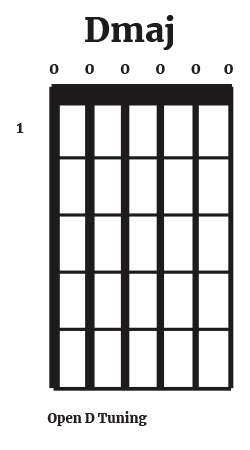
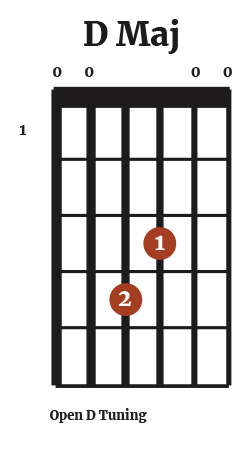
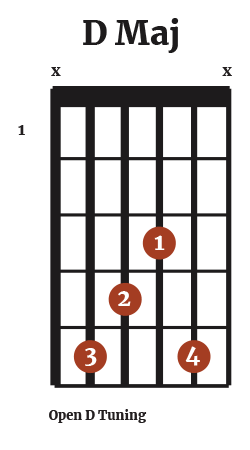
The third example builds on example 2. When playing a D major chord using this fingering we are not required to mute the 1st and 6th strings, however, by not including strings 1 and 6 the chord shape becomes moveable. Meaning we can move the entire shape up or down the fretboard to play different chords.
Open D Chord Shapes
Before we start learning more chords in Open D Tuning it’s a good idea to learn the major scale on the 6th string, as this indicates the root note for the major triads we’re about to learn in the key of D (more on scales shortly).

Major Chords in Open D
While there are numerous ways to voice chords regardless of the tuning, one simple way to play major triads in open tunings is to simply barre the strings being played.

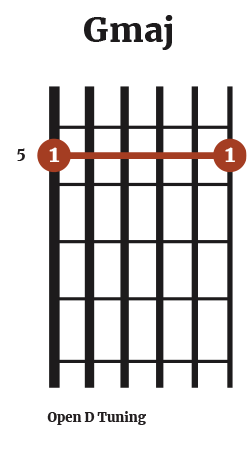
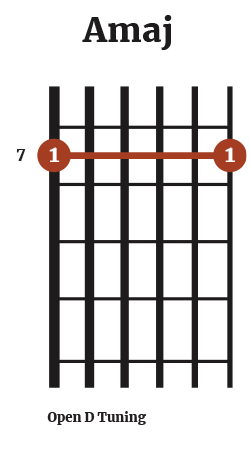
For example, to play a simple I-IV-V chord progression in the key of D we can play all 6 open strings for the I chord (D major), barre all strings at the 5th fret for the IV chord (G major), and then move up 2 frets to the 7th fret to play the V chord (A major).
Remember. Use the major scale example above to identify the root notes of each of the chords.
Minor Chords in Open D
To play minor chords in any tuning, especially alternate tunings where you may not be as familiar with the layout of the fretboard, it’s good practice when first getting started to learn at least a couple of moveable shapes. However, be aware this negates the lush sound of including open strings in your chords.
The chords below are all moveable, based on the root note found on the 6th string.
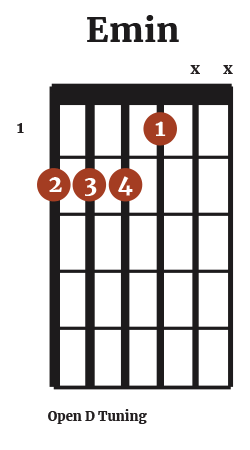


Moveable chord shapes are a great way to get started in alternate tunings, for a couple of reasons, aside from making the fretboard more navigable:
- Consistent Sound Quality: Movable shapes maintain a consistent tonal quality across the fretboard. e.g. you are hitting the same number of strings each time. This consistency is useful, where a coherent sound character is essential for the music’s emotional impact.
- Enhanced Musical Creativity: The ease of moving a single chord shape up and down the fretboard encourages exploration and improvisation. Guitarists can easily experiment with different chord progressions and melodies, fostering creativity and compositional skills.
Of course, there are many ways to voice chords, below is another example of a moveable minor chord shape in Open D tuning, which requires muting, or not playing string 5 and 6.
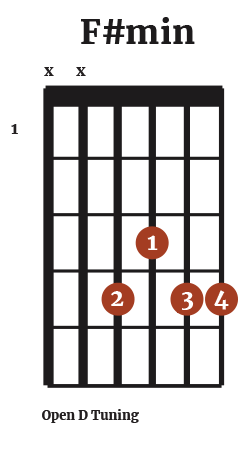
All Chords in the Key of D in Open D Tuning
Below are all 7 chords in the key of D in Open D tuning, the VII chord is a diminished C# chord. Focus on the major and minor chords, at least to begin with.
Diminished chords are encountered far less often as the VII chord in a key primarily due to their dissonant and unstable sound, which often doesn’t align with the harmonic goals in many music styles.

*I have included different voicings from the example provided above to demonstrate some additional, useful, chord shapes.
7th Chords in Open D
Seventh chords are great because they add depth and complexity to music, enriching the harmonic texture and creating a sense of tension and resolution. If you are unfamiliar with 7th chords, be sure to read my guide here.
Below are some examples of 7th chords in the key of D in Open D tuning.
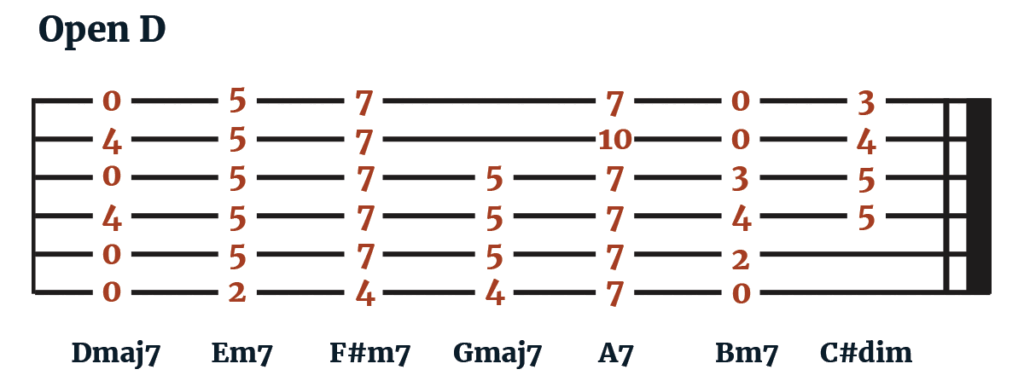
Every closed chord shape above e.g. chords that contain no open strings, is moveable. For example, learning the a7 shape above allows you to move between major and 7th chords by simply adding the pinky three frets higher up the fretboard.
So, if playing a G major chord by barring the 5th fret, a G7 chord will always be available by adding the pinky to the 2nd string 3 frets higher e.g. the 8th fret, for that bluesy dominant 7th sound.
Scales in Open D
We’ve already touched on the D major scale on the 6th string, but let’s look at a few more practical examples.
When first getting started it’s advisable to start with the major scale, as it forms the foundation of Western music theory and is crucial for understanding other scales.
The D major scale is a natural choice in this tuning, as the open strings already provide the tonic notes.
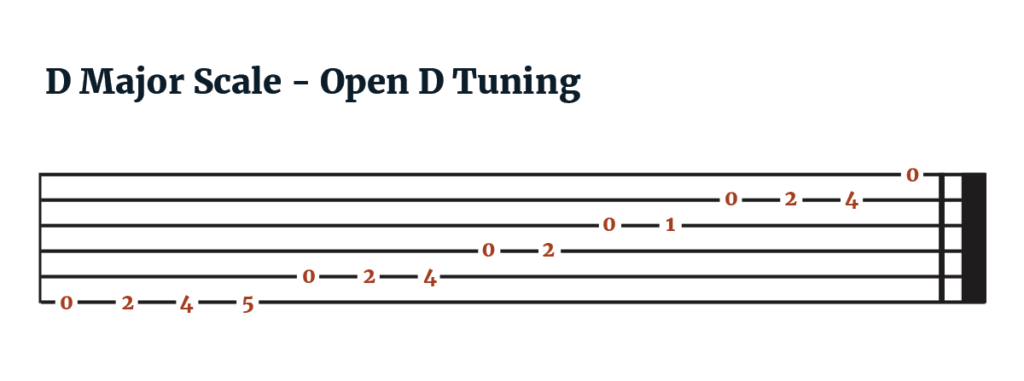
After mastering the major scale, try the minor pentatonic, and blues scales to further enhance your versatility.
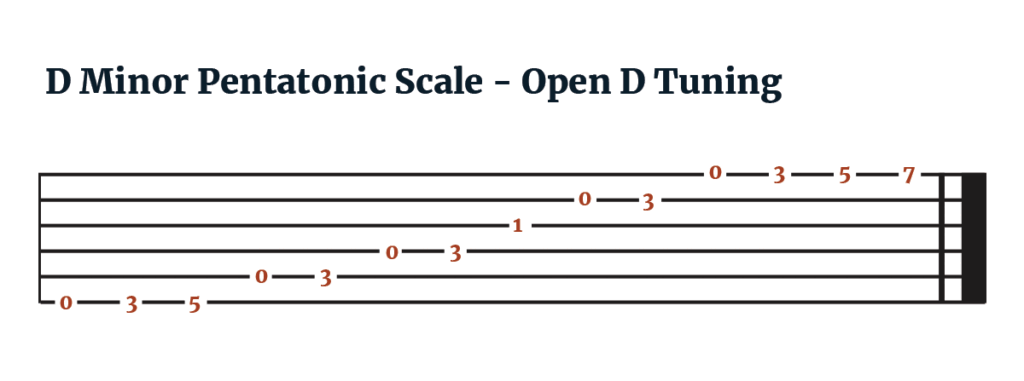
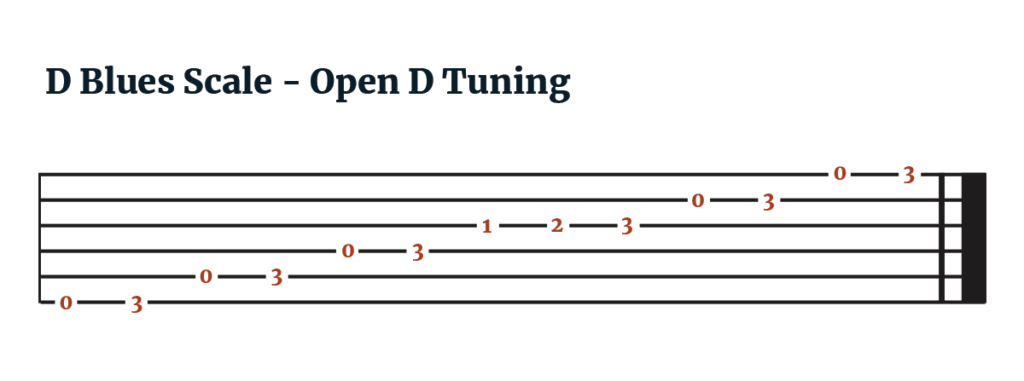
These scales are fundamental in various music genres, from blues and folk to rock and jazz, and learning them in open D tuning can provide fresh insights and techniques that are transferable across different tunings and musical styles.
Using scales is foundational for writing music, forming the backbone of song structures. When writing riffs, scales offer a palette of notes to choose from, ensuring harmonic coherence.
Remember, different scales can set various moods and atmospheres in your compositions, from upbeat to somber. As your familiarity with the scales above grows, incorporating modes and altered notes can add complexity and uniqueness to your music.
Writing Music in Open D
Open tunings such as Open D offer a unique creative landscape. Here are my top three tips for writing in Open D when first getting started.
- Leverage Open Strings for Melodic Playing: Open D tuning naturally lends itself to rich, droning sounds. Use open strings as a sonic backdrop and play melodies on the higher strings. This can add a layer of depth and texture to your music.
- Slide and Hammer-Ons/Pull-Offs: Open D is perfect for slide guitar techniques, offering a fluid, expressive sound. Similarly, hammer-ons and pull-offs can sound particularly effective in this tuning, allowing for smooth transitions and a fluid playing style.
- Experiment with Alternate Picking and Strumming Patterns: The different string relationships in open D can inspire unique rhythmic patterns. Try alternate picking techniques or varied strumming patterns to bring out the richness of the tuning.
Additionally, having both the lowest and highest strings tuned to the same note simplifies the navigation of the fretboard, as it offers a consistent reference point for both bass and treble, making it easier to explore and create music within this tuning.
Remember, by embracing the distinct characteristics of open D tuning, you can unlock new creative possibilities and add a fresh sound to your guitar-playing. Use your lack of familiarity with the fretboard layout to your advantage.
Inspiration: History of Open D Tuning
Of course, one of the best ways to create new music is to take inspiration from other artists, and Open D tuning has a rich history having played a significant role in the evolution of the blues.
The cradle of the Delta blues, the Mississippi Delta, saw musicians adapting open tunings, including Open D which lent itself well to the narrative and soulful qualities of early blues.
Several iconic blues musicians are known for their mastery of Open D tuning, including Robert Johnson, Elmore James, Blind Willie McTell, and Booker White (Bukka White), to name just a few.
McTell’s “Statesboro Blues” is a classic example of a blues song played in Open D tuning, showcasing the deep, resonant sound characteristic of the tuning.
But Open D tuning isn’t strictly limited to the blues by any means. Big Yellow Taxi, by Joni Mitchel, is written in Open D. Stone Gossard of Pearl Jam employs Open D tuning for the song Even Flow, John Mayer tuned to Open D for the iconic ‘Daughters’ and Beck wrote his breakthrough hit ‘Loser’ with its distinctive fusion of alternative rock, folk and blues in open D tuning.
Final Thoughts
Open D tuning on the guitar offers a fresh avenue for creativity and expression, making it a valuable addition to any guitarist’s repertoire, especially if you are just getting started with alternate tunings.
This guide has covered essential aspects, from tuning your guitar to Open D, understanding chord shapes, scales, and songwriting techniques, to drawing inspiration from its historical roots.
As you begin playing in Open D, remember that experimentation and exploration are key. Embrace the unique qualities of this tuning to discover new sounds, develop your skills, and perhaps even find your own signature style. With practice and patience, Open D tuning can be a gateway to a whole new world of musical possibilities, enhancing both your playing and your songwriting prowess.

